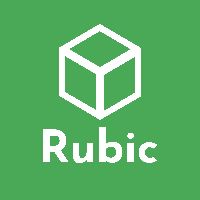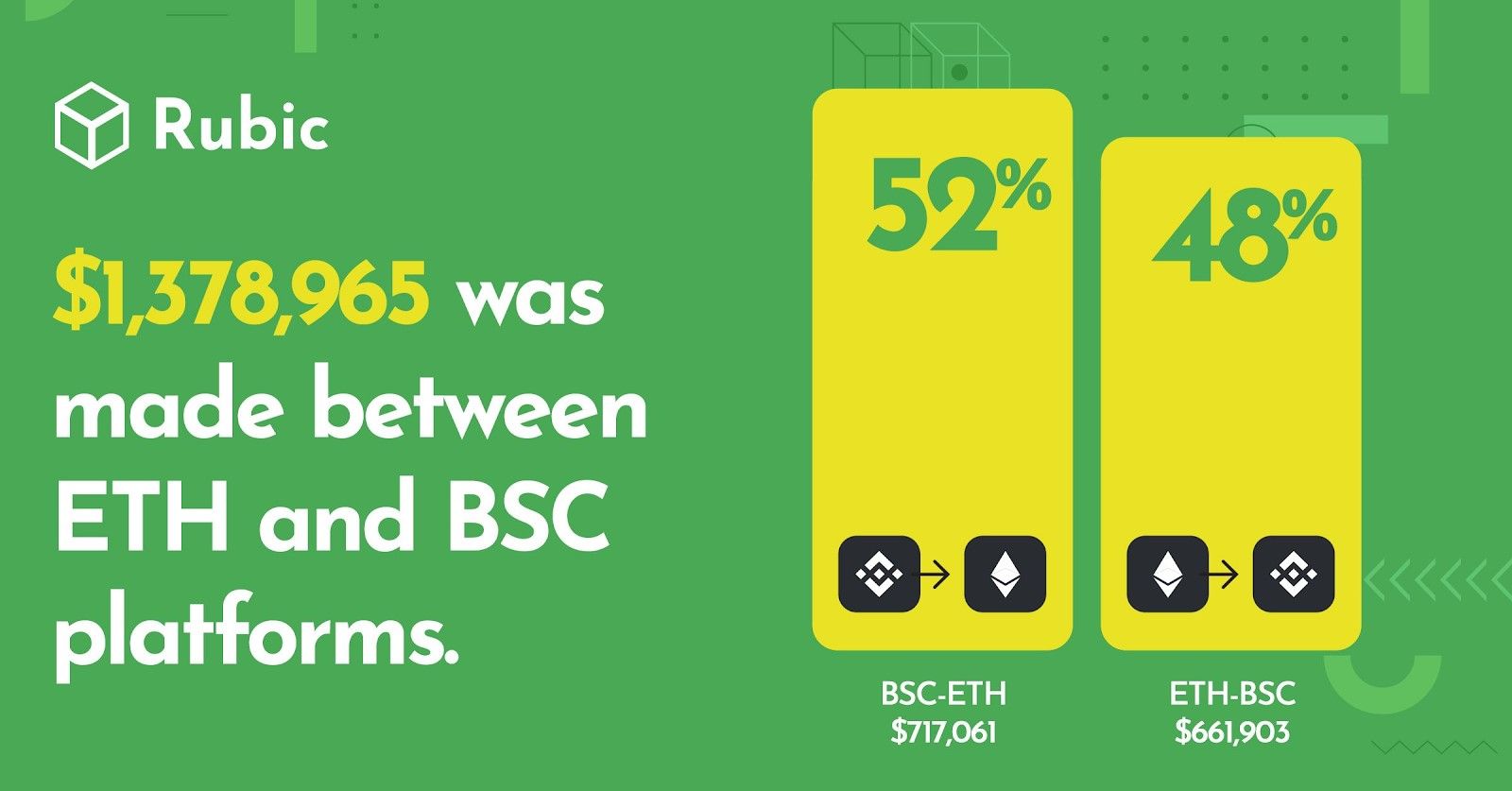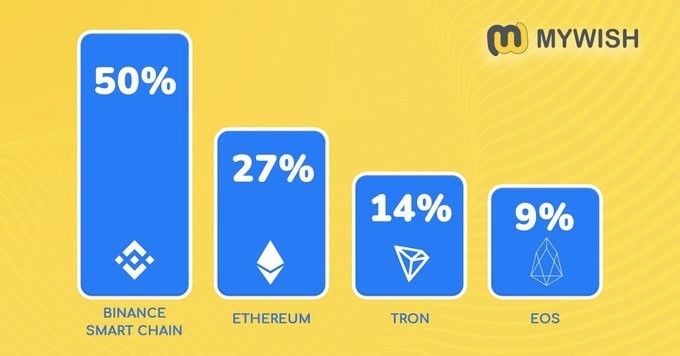
@rubicfinanceRubic Finance
Rubic organizes defi services to enable a project to create, manage and trade tokens decentralized in ONE PLACE.
Introduction
During 4 years as an active crypto developer and business builder, I created several projects including:
Rubic: multichain DeFi ecosystem, which features cross-chain, P2P, and instant swaps across multiple blockchains, aiming to deliver a complete ONE-STOP decentralized platform.
MyWish: Leader of Smart Contract Generation (no coding needed).
For all these years, I can now say that with my team, we are able to see and interpret crypto trends through our platforms, giving relevant analysis and sharing opinions about it. Today, I will share with you exclusive data about Ethereum and Binance Smart Chain, and how we are networking with them.
Currently, on our project called Rubic, we have integrated Panama Binance Bridge. This solution allows people to swap 25 pairs of tokens between Ethereum and BSC networks. For the past 5 weeks, we collected statistics concerning this Bridge, and I would like to introduce you to the latest trends in cross-chain swaps.
ETH vs BSC statistics
- Crypto transfer from ETH to BSC / BSC to ETH
Ethereum is undoubtedly the king of smart contracts right now. Every metric proves the domination of ETH network in attracting demand for decentralized apps, at the moment.
For the past year, the Ethereum ecosystem had a very high growth rate and surely will continue its dominance in the near future. However, the demand has led to crazy gas prices. These gas prices have boxed out many people from partaking in the Ethereum network lately.
The BSC network, which is compatible with the Ethereum Virtual Machine, (EVM) can be easily ported over ETH apps and users. This is proven by seeing more and more migrated apps and users, who don’t want to pay these enormous gas fees.
By referring to the Rubic Finance exchange platform, the last 7-8 weeks, an amount of $1,378,965 was made between Ethereum and BSC platforms. (51,5% of transactions: BSC -> Ethereum ($717,061) ; 48,5% of transactions: Ethereum -> BSC ($661,903).

Many tokens are used on cross-chain between ETH and BSC (Bridge)
By converting all the tokens transferred during the period of the end of January and early March, there were in total about $1,378,965 worth. The biggest part of the cryptocurrencies traded were ETH and WETH and few more:
- DAI
- BUSD-T
- USDT
- USDC
- LINK
- FRONT
- 1INCH
The core statistics of both ETH and BSC networks are showing everyday BSC lead in transaction volumes until now. This could prove the statement that people are tired of paying for gas and are looking for a solution that would help them to trade cheaper. Also, it’s important not to forget about small traders, who sometimes need to pay half of the transaction volume as a gas fee.
For all of these users, it is critical to move their assets to BSC or other networks to complete trades without paying big gas fees. The solution for all of these users is to use cross-chain solutions. Current Binance Smart Chain bridge (Panama) is the most popular cross-chain solution at the market, but not only to transfer their tokens to the BEP-20 but also to turn them back to ERC-20.
But why would people do that if everyone is pissed with gas prices of ETH network?
After analyzing our data I have discovered that people are looking forward to trading on the BSC platform, to prevent them from paying extra gas, but ETH network is more popular among the community. And because of that users are holding their assets at ETH network.
ETH vs BSC analytics
As a result, the daily trading volume on Binance increased by 30% on February 10, then by 70% on February 18 against Ethereum, as the two networks continued to gain popularity and value side by side. On 20th February, 1.33 million daily transactions were recorded on Ethereum.
Practically at the same time, on Binance there were recorded 2.88 million transactions on the 19th of February.
Whether this is through exploring exciting new DeFi features or because transaction fees are low today, users are increasingly turning to Binance.
Binance Managing Director Changpeng Zhao (CZ) has repeatedly encouraged developers and DeFi projects to leave the Ethereum ecosystem in favor of Binance while noting that BSC is “a support network” for the Ethereum ecosystem. The shift of users to the BSC platform is explained by the fact that the demand for affordable DeFi products is increasing, as the platform manages to keep gas costs quite low ($ 0.04) compared to Ethereum. ($ 5.53), a notable difference for BSC which is 135 times cheaper.
Smart Contracts – MyWish
With MyWish platform affiliated to the Rubic platform, we saw that from the middle of February 2021, 10 smart contracts were built on Ethereum and 40 smart contracts on Binance. It shows that a serious development is taking place about smart contracts on the Binance side, perhaps because of the competitive gas fees.

Conclusion
From all the data that has been presented here as well as public statistics, BSC has in its last months attracted a large number of users. But looking at current trends, a lot of users tend to switch back to Ethereum to hold their assets.
Perhaps BSC will manage to maintain a regular customer base by becoming a more complete DeFi platform. The main reason why people dislike the BSC network is that it relies on a system of 21 validators, while Ethereum has more than 77,800 active validators.
This is the key moment for a lot of blockchain users, and it’s the reason why some people distrust holding their assets on the BSC network. Currently, BSC is increasing the number of validators with projects like “Ankr” and “Certik”. In the future, BSC will increase the number of validators and the platform will gain more trust from users.

Because trades between Ethereum and Binance Smart Chain have increased consequently, this week on the Rubic platform, users will have the possibility to exchange to Binance Smart Chain and make instant trades from Rubic directly.
The platform allows users to not only exchange from one blockchain to another but also trade immediately on this blockchain. Also, it allows them to optimize the gas fees they want to spend. Rubic’s purpose is simple, unifying all blockchain exchange services together on one single platform for ease of use through instant trades and order books.
Featured image: knssr / Adobe Stock
